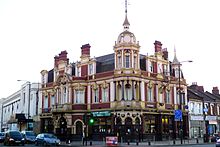William Edward Trent



William Edward Trent (1874 - 1948)[1] was a British architect.
Early life[]
His cousin was the sculptor and medallist Newbury Abbot Trent.[2]
Career[]
Together with Henry Poston, to whom he was apprenticed, and then his assistant,[1] he was the architect for the Earl of Essex, a Grade II listed public house at 616 Romford Road, Manor Park, London, built in 1902.[3]
Having been articled to Henry Poston of Lombard Street, London in 1892, he remained with Poston as his assistant until he started an independent practice in London in 1905.[1]
From 1909, Trent specialised in cinema design. This led to his appointment first as the chief architect to (PCT), and then as architect to the Gaumont British Picture Corporation, which took over PCT in 1929.[1] These cinemas/theatres included the Regent Theatre, Ipswich, Apollo Victoria Theatre[citation needed] and the Gaumont Finchley (1937), designed with the assistance of his son W. Sydney Trent and R. Golding.[4]
Personal life[]
His son William Sydney Trent (1903-1944) was also an architect. When his father became a full-time employee of PCT, his son took over his private practice, retaining him as a consultant. However, he joined Gaumont British in 1932 to help his father with the huge increase in work with the advent of talking pictures.[1]
References[]
- ^ Jump up to: a b c d e "William Edward Trent". Scottisharchitects.org.uk. Retrieved 20 June 2014.
- ^ "Curzon Chelsea Cinema". Cinematreasures.org. Retrieved 20 June 2014.
- ^ Historic England. "Earl of Essex public house (1357990)". National Heritage List for England. Retrieved 20 June 2014.
- ^ Gillies, Stewart & Pamela Taylor. (1992) Finchley and Friern Barnet: A Pictorial History. Chichester: Phillimore. Picture caption 180. ISBN 0850338441
External links[]
![]() Media related to William Edward Trent at Wikimedia Commons
Media related to William Edward Trent at Wikimedia Commons
- Public house architects
- 1874 births
- 1948 deaths
- Architects from London
- British architect stubs